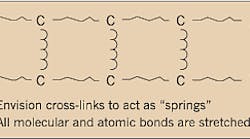Cold shrink and heat shrink tubing have different applications, installation techniques, and physical properties. Make sure you know when to use each type
Cold shrink and heat shrink tubing may appear similar from the outside, but their key performance characteristics are very different. Both types of tubing can be used in a variety of applications for splicing, terminating, and environmentally sealing electrical cables for low-voltage and medium-voltage applications. Choosing between cold shrink and heat shrink tubing, however, is more difficult than just picking the least expensive or most familiar type.
The most obvious difference is that cold shrink comes stretched over a removable core, allowing you simply to slide the tube over the splice or termination and unwind the core, letting the cold shrink tube contract to fit snugly over the cable. Heat shrink requires a heat source, usually a torch, to shrink it over the splice or termination. Heat shrink also requires more skill to prepare and apply. Arming yourself with information about the differences should help you make the correct choice for your next application.
The secret to the shrink.
Although they're used for different applications, both types of tubing use the same material science of cross linking to achieve shrinkage. The materials that make up the insulation — ethylene propolyne diene monomer (EPDM) or silicone rubber in the case of cold shrink, and ethylene vinyl acetate (EVA) in the case of heat shrink — are cross linkable, which allows them to stretch and then shrink onto the cable.
In both cold shrink and heat shrink products, cross linking is a process that forms bonds that act like springs between the long-chain molecules of the material in the tubing; when the tubing is stretched those bonds try to return the material to its original shape (Fig. 1). The more these materials are cross linked, the stronger their desire to return to their original shape. The distance that the material stays expanded beyond its original diameter is called permanent set.
The manufacturer provides an application range that takes into account the permanent set of the material (Fig. 2). This application range will ensure continuous inward pressure during the life of a cold shrink product. Because of this living seal, cold shrink is best-suited for situations where large load swings or temperature differences occur. As the cable expands and contracts with these differences in temperature, the cold shrink product will expand and contract with the cable to maintain a tight seal.
Although the cross linking concept is the same in both types of tubing, the composition of the materials and how they respond to temperature changes is different. As the material used in heat shrink tubing, EVA is characterized by crystalline regions that allow it to remain stretched at normal temperatures. During manufacture, the tubing is heated above the crystalline melt temperature, allowing the tubing to expand. Once it has been stretched, it's then cooled below the crystalline melt temperature, crystallizing those regions and making them rigid again. The product is shipped in the stretched state.
To form a tight seal around cabling, heat shrink tubing must be heated again by the end-user. Reheating the tubing melts the crystalline regions again and causes it to shrink. After the product shrinks onto the cable and the heat source is removed, the crystalline regions resolidify and become rigid. Under most operating conditions, these regions remain in crystalline form and, therefore, exert no inward pressure on the cable. As a result, most heat shrink products use hot melt adhesives and mastics to environmentally seal the cable because the heat shrink material doesn't expand or contract with the cable.
Installation can be quick or quicksand.
Installation techniques differ greatly from cold shrink to heat shrink tubing. Whereas cold shrink products can be installed without special tools, heat shrink products require a torch and more skill. Cold shrink generally installs with consistent insulation wall thickness, regardless of the installer's level of training. The insulation wall thickness of heat shrink can vary depending on the skill of the installer. This uneven heating — a possibility when cramped spaces, such as manholes, limit access to all sides of the tubing — can cause variations in the thickness of insulation.
The introduction of a torch for heating purposes also makes it necessary to take extra caution to prevent injury to other workers or damage to the cable or anything else in the surrounding area. Manhole installations are even more troublesome. In such instances, the presence of combustible gases can cause an explosion if brought into contact with the flame from the torch. The gases expelled by the torch's flame must be vented from the manhole, and fresh oxygen must be pumped in for worker safety. For those reasons, cold shrink products are a safer option when working in manholes and other areas where gases may concentrate.
It's also important to consider work permit issues. A hot work permit is typically necessary when installing any heat shrink products, whereas the installation of cold shrink tubing requires only a standard work permit. It can be difficult to obtain a hot work permit while a facility is running, so plan accordingly.
What's hot and what's not about each.
Silicone, used in cold shrink products, is inherently UV-resistant and therefore won't be affected by the sun. It also inherently repels water and has fairly good chemical resistance to most, but not all chemicals. Silicone, however, isn't very tough or abrasion-resistant. It's recommended for outdoor, above-ground applications because of its UV resistance and ability to repel water. Silicone materials perform very well in high and low temperatures. From a cold shrink installation standpoint, silicone materials shrink onto the cables the same at 230°C as they do at 60°C. Once installed, the materials will perform in much colder and hotter temperatures than the installation temperatures. Because of these properties, for example, silicone would be well-suited for medium-voltage terminations and outdoor applications.
EPDM rubber, also used in cold shrink tubing, is tough and abrasion resistant and has fairly good chemical resistance to most, but not all chemicals. It has been used in direct burial applications for more than 25 years. It requires additives to make it more UV-resistant and more suitable to repel water for above-ground applications, but works well underground. EPDM materials aren't recommended for applications that will bring them in close contact with hydrocarbons because they tend to swell and lose some of their physical properties in such situations. EPDM is a good choice for direct burial applications, especially manhole installations.
The temperature of the environment in which the tubing will be used should also be a consideration. Contrary to its name, cold shrink insulation made of EPDM shrinks very slowly below 32°F. However, it will still contract to the size it's meant to be. You can speed up the shrinking process by squeezing it or warming it up.
In addition to being tough and abrasion-resistant, EVA, used in heat shrink tubing, resists most chemicals. Heat shrink has been used in direct burial applications for more than 20 years. It requires additives to make it more UV-resistant and able to repel water for above-ground applications, but works well underground. It's well-suited for rejacketing in direct burial applications.
EVA and EPDM are very similar in their ability to resist water penetration. While both work well, only metal is truly moisture-impervious.
Cold shrink tubing is more pliable than heat shrink materials, which allows it to move with the cable as it goes through load cycling expansions and contractions and to maintain a lifelong environmental seal and interface pressure on the cable. EPDM is also physically very tough and able to withstand physical abuse and abrasion. EPDM and silicone materials won't change physical properties until they're heated to well over 200°C.
Heat shrink tubing, on the other hand, is typically very rigid at room temperature, making it a good choice for mechanical protection at these temperatures. However, this rigidity prevents it from moving with the cable and maintaining an environmental seal without mastics and hot melt adhesives. The crystalline regions that provide this rigidity typically melt between 90°C and 110°C, and when they melt, the tubing becomes softer and less resistant to abrasion. As such, heat shrink material works best as a jacketing material where the temperatures are below 90°C if abrasion resistance and/or chemical resistance are required.
Finally, when working outdoors, temperature can have an effect on the success of the installation. When working in temperatures below freezing, you should keep all insulation materials — whether cold shrink or heat shrink — in the heated cab of a truck until the cable is prepared and you're ready to install the accessory.
Every cabling installation has a different combination of requirements for chemical, water, and abrasion resistance. Factor in temperature considerations, and choosing installation can become difficult. However, heat shrink and cold shrink tubing offer options for several applications. Although you should check with the manufacturer for specific chemical resistances and applicability for unusual environmental applications, together both forms of tubing are capable of handling most requirements.
Taylor is an electrical engineer in product development for the 3M electrical products division, Austin, Texas.





